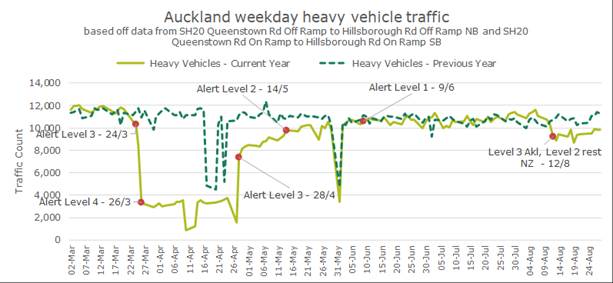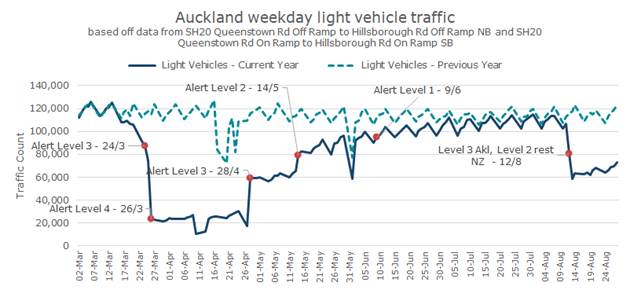September 2020 Newsletter
Greetings from the Southern Hemisphere,
Weather Report
It is traditional in these newsletters to give a local weather report. In New Zealand we have just moved into spring. Daylight saving came into effect here last weekend. The winter has been very mild here but in the last two weeks we have had a couple of storms. These have been just a few days of rain and high winds but one of them has had a significant impact on our transport infrastructure. Auckland, where I live, is New Zealand’s largest city and lies on an isthmus. At the narrowest points, the distance between the west and east coast is less than three kms. The main North-South highway crosses the harbour on an eight-lane bridge which carries 170,000 vehicles a day. Two weeks ago during a storm, peak wind gusts of up to 127 km/h caused two trucks to be blown over while crossing the bridge. One of these trucks caused significant damage to one the structural struts on the bridge. Since then the bridge has been operating at reduced capacity causing significant additional traffic congestion. There is an alternative route but this is also congested. Repairs to the bridge are expected to be completed this weekend. There are long-term general plans for an additional harbour crossing but this is considerable debate about what form this additional crossing should take. The current incident has stimulated discussions on whether construction of the additional crossing should be brought forward to improve the resilience of the network.
HVTT16
As you will all be aware, the Covid-19 pandemic has prevented us from holding HVTT16 in Qingdao this year as planned. The symposium has been rescheduled and will be held in Qingdao on 4-7th September, 2021. In view of the uncertainty around international travel next year due to the Covid-19 pandemic, the symposium will operate in a hybrid form with both in-person and on-line attendance options available. Authors will be able to present their paper without attending the conference in person. All paper submissions for this year’s symposium will be transferred to next year’s symposium. Most of these have now been peer reviewed and authors will be informed shortly of the review outcomes. Because of the postponement of the symposium, we will be issuing a supplementary call for papers in the next few weeks. In addition we will be offering authors an option to have their full paper published on the HVTT Forum website by the end of this year. These pre-published papers will still be presented at the symposium in September but will be available for referencing before that.
Covid-19 and Road Safety
In undertaking road safety risk analysis we often assume that the risk is proportional to exposure. For small changes in exposure this is a reasonable assumption. However, when we consider large changes in exposure the situation is more complicated. For example, as traffic volumes increase we expect more congestion and reduced speeds which could reduce the crash risk or crash severity. Analysing these effects is complicated. Although we could look at the situation today compared to, say, ten or twenty years ago, as, in that time exposure will probably have increased significantly, but many other relevant factors will also have changed. Vehicle safety technology has improved and most road controlling authorities are continually looking for ways to improve the safety performance of their infrastructure assets.
In New Zealand, Covid-19 provides us with an opportunity to evaluate the relationship between crash risk and exposure. We entered a full lockdown on March 25th which lasted for just over a month which was followed by reduced restrictions for a further two weeks. During the full lockdown, private passenger car travel was banned for everyone except essential workers. Road freight was designated an essential service but volumes were reduced because of the slowdown in economic activity. The figures below show the light vehicle and heavy vehicle weekly traffic counts for last year and the current year at a site in Auckland. During the full lockdown, light vehicle traffic was down from approx. 120,000 to just over 20,000 while heavy vehicle was down from about 11,500 to about 3,500, i.e. light vehicle traffic was at about 17% of normal levels while heavy vehicle traffic was at about 30% of normal levels.


The monthly National road fatality data is shown below. Note that in 2019, April had the highest monthly road fatalities followed by December. This is because of the Easter holidays in April and the Christmas holidays is December which generate a lot of light vehicle traffic to holiday destinations and unfortunately also high fatality numbers. Combining the light and heavy traffic data above we see that overall traffic levels were about 18% of the previous year for April and the number of fatalities was 20% of the previous year. This tends to support the crash risk is proportional to exposure model. Using serious crash numbers rather than fatalities will give a more robust result because the numbers are larger but the data for serious crashes has not been published yet.
| Jan | Feb | Mar | Apr | May | Jun | Jul | Aug | Sep | Oct | Nov | Dec | |
| 2019 | 32 | 26 | 33 | 45 | 29 | 28 | 14 | 24 | 25 | 19 | 36 | 41 |
| 2020 | 21 | 32 | 31 | 9 | 23 | 29 | 33 | 25 |
As a side note, the number of road fatalities for the year to the end of August 2020 is 28 lower than it was for the corresponding period in 2019. By comparison, the total number of Covid-19 deaths in New Zealand to the end of August was 22 (it is now 25). Suppressing the spread of Covid-19 in New Zealand has been a challenge but, as a nation, we are quite proud of what we have achieved.
I hope that you are all well and that many of you will participate in HVTT16 next year. If you can’t attend in person, the on-line option will be available.
Best wishes.
John de Pont
Vice President – Australasia
HVTT Forum
